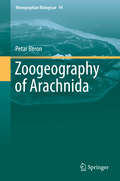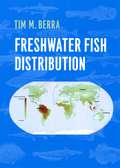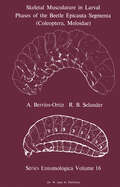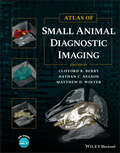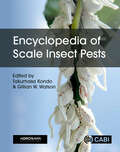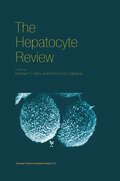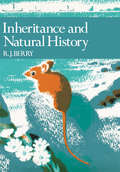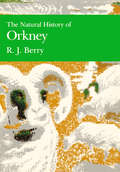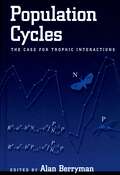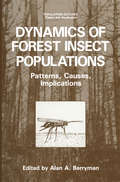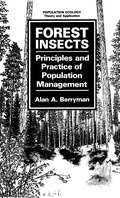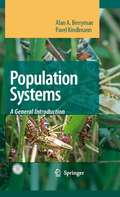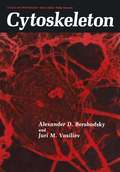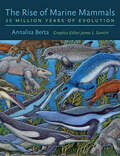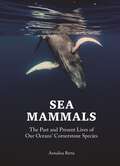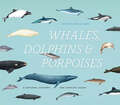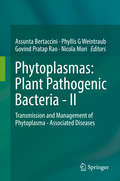- Table View
- List View
Zoogeography of Arachnida (Monographiae Biologicae #94)
by Petar BeronThis volume merges all geographical and paleogeographical data on all groups of the arachnofauna. The book features topics such as the ecological factors, climate and other barriers that influence the distribution of arachnida. It also elaborates on the characteristics of the distribution such as arachnida at high altitude (e.g. Himalaya), in caves, in polar regions and highlights differences between the arachnofauna of e.g. Mediterranean regions vs Central Europe, West African vs Indomalayan and more. Furthermore, amongst other topics the volume also includes chapters on the systems of arachnida, fossil orders, dispersal and dispersion, endemics and relicts, regional arachnogeography, cave and high altitude arachnida.
Freshwater Fish Distribution (American Politics And Political Economy Ser.)
by Tim M. BerraWith more than 29,000 species, fishes are the most diverse group of vertebrates on the planet. Of that number, more than 12,000 species are found in freshwater ecosystems, which occupy less than 1 percent of the Earth’s surface and contain only 2.4 percent of plant and animal species. But, on a hectare-for-hectare basis, freshwater ecosystems are richer in species than more extensive terrestrial and marine habitats. Examination of the distribution patterns of fishes in these fresh waters reveals much about continental movements and climate changes and has long been critical to biogeographical studies and research in ecology and evolution. Tim Berra’s seminal resource, Freshwater Fish Distribution,maps the 169 fish families that swim in fresh water around the world. Each family account includes the class, subclass, and order; a pronunciation guide to the family name; life cycle information; and interesting natural history facts. Each account is illustrated, many with historical nineteenth-century woodcuts. Now available in paperback, this heavily cited work in ichthyology and biogeography will serve as a reference for students, a research support for professors, and a helpful guide to tropical fish hobbyists and anglers.
Freshwater Fish Distribution
by Tim M. BerraWith more than 29,000 species, fishes are the most diverse group of vertebrates on the planet. Of that number, more than 12,000 species are found in freshwater ecosystems, which occupy less than 1 percent of the Earth’s surface and contain only 2.4 percent of plant and animal species. But, on a hectare-for-hectare basis, freshwater ecosystems are richer in species than more extensive terrestrial and marine habitats. Examination of the distribution patterns of fishes in these fresh waters reveals much about continental movements and climate changes and has long been critical to biogeographical studies and research in ecology and evolution. Tim Berra’s seminal resource, Freshwater Fish Distribution,maps the 169 fish families that swim in fresh water around the world. Each family account includes the class, subclass, and order; a pronunciation guide to the family name; life cycle information; and interesting natural history facts. Each account is illustrated, many with historical nineteenth-century woodcuts. Now available in paperback, this heavily cited work in ichthyology and biogeography will serve as a reference for students, a research support for professors, and a helpful guide to tropical fish hobbyists and anglers.
Skeletal Musculature in Larval Phases of the Beetle Epicauta Segmenta (Series Entomologica #16)
by A. Berrios-Ortiz R.B. SelanderThis study, the first in an intended series of anatomical investigations of the blister beetles, was undertaken primarily for the purpose of determining the changes that occur in the skeletal musculature during postembryonic larval development. The species studied, Epicauta segmenta (Say), like others belong ing to the coleopterous family Meloidae, is characterized by hypermetamor phosis (SELANDER and WEDDLE, 1969). The egg develops into an active, well sclerotized larva that searches for grasshopper eggs, which, as in the case of all species of Epicauta, serve as the sole larval food. This triungulin phase of the larval stage, as it is called, is followed by the first grub phase (Fig. 1), during which the larva continues to feed and undergoes several molts. After feeding is completed the larva commonly enters a sessile, diapausing coarctate phase in which the integument is heavily sclerotized and the appendages, including the legs, are vestigial (Fig. 2). Following this the larva attains an active second grub phase (Fig. 3) closely resembling the first grub phase in external anatomy. Normally, the second grub phase leads directly to pupation and the formation of the adult. An alternate, abbreviated developmental pattern, involving pupation immediately after the first grub phase, is also recorded in this and many other species of Epicauta.
Atlas of Small Animal Diagnostic Imaging
by Clifford R. Berry Nathan C. Nelson Matthew D. WinterATLAS OF Small Animal Diagnostic Imaging Comprehensive and up-to-date resource on the interpretation of diagnostic images in small animals using survey radiographs and other modalities Atlas of Small Animal Diagnostic Imaging provides a comprehensive, multimodality atlas of small animal diagnostic imaging, with high-quality images depicting radiography, scintigraphy, ultrasonography, computed tomography, and magnetic resonance imaging. Taking a traditional body systems approach, the book offers an image-intensive resource to survey radiographs with some other imaging modalities being used to emphasize interpretation of survey radiographs. The Atlas offers clinically relevant information for small animal practitioners and students. Each body structure is thoroughly covered and well-illustrated, with discussion of the strengths and weaknesses of each modality in various scenarios. Edited by three experienced radiographers, The Atlas of Small Animal Diagnostic Imaging contains information on: Basics of diagnostic imaging, physics of diagnostic imaging, CT and MRI physics, US physics, and nuclear medicine physics Musculoskeletal normal anatomic variants, developmental orthopedic disease, joint disease, fracture and fracture healing, aggressive bone disease, and head and spine imaging Thorax anatomy, variants, and interpretation paradigm, extrathoracic structures, pleural space, pulmonary parenchyma, and mediastinum Abdomen anatomy, variants, and interpretation paradigm, extra-abdominal and body wall, peritoneal and retroperitoneal, liver and biliary, and spleen With its expansive coverage of the subject and hundreds of high-quality images to aid in efficient and seamless reader comprehension, Atlas of Small Animal Diagnostic Imaging is an invaluable and must-have resource for small animal practitioners, veterinary students, veterinary radiologists, and specialists in a number of areas.
Atlas of Small Animal Diagnostic Imaging
by Clifford R. Berry Nathan Nelson Matthew D. WinterATLAS OF Small Animal Diagnostic Imaging Comprehensive and up-to-date resource on the interpretation of diagnostic images in small animals using survey radiographs and other modalities Atlas of Small Animal Diagnostic Imaging provides a comprehensive, multimodality atlas of small animal diagnostic imaging, with high-quality images depicting radiography, scintigraphy, ultrasonography, computed tomography, and magnetic resonance imaging. Taking a traditional body systems approach, the book offers an image-intensive resource to survey radiographs with some other imaging modalities being used to emphasize interpretation of survey radiographs. The Atlas offers clinically relevant information for small animal practitioners and students. Each body structure is thoroughly covered and well-illustrated, with discussion of the strengths and weaknesses of each modality in various scenarios. Edited by three experienced radiographers, The Atlas of Small Animal Diagnostic Imaging contains information on: Basics of diagnostic imaging, physics of diagnostic imaging, CT and MRI physics, US physics, and nuclear medicine physics Musculoskeletal normal anatomic variants, developmental orthopedic disease, joint disease, fracture and fracture healing, aggressive bone disease, and head and spine imaging Thorax anatomy, variants, and interpretation paradigm, extrathoracic structures, pleural space, pulmonary parenchyma, and mediastinum Abdomen anatomy, variants, and interpretation paradigm, extra-abdominal and body wall, peritoneal and retroperitoneal, liver and biliary, and spleen With its expansive coverage of the subject and hundreds of high-quality images to aid in efficient and seamless reader comprehension, Atlas of Small Animal Diagnostic Imaging is an invaluable and must-have resource for small animal practitioners, veterinary students, veterinary radiologists, and specialists in a number of areas.
Wolfish: The stories we tell about fear, ferocity and freedom
by Erica BerryA MOST ANTICIPATED BOOK OF 2023 FOR FINANCIAL TIMES, TIME, VULTURE, LIT HUB, GOODREADS, RUMPUS, BUSTLE, READER'S DIGEST and more Both vilified and venerated, wolves abound through cultural folklore and literature. In this hauntingly lyrical and unflinching inquiry, Erica Berry untangles these depictions - alongside her own research of the wolf and experience as a woman - to try to understand how we navigate terror, vulnerability and violence in our fragile, often dangerous world. Luminously wise and unusually brave, Wolfish will stay with you long into the night.
Encyclopedia of Scale Insect Pests
by Jocelyn A. Berry Manuela Branco Lyle Buss Mr Alejandro Caballero Mr Juang Horng Chong Lucía E. Claps C. De Klerk Rodrigo Diaz Imre Foldi Antonio P. Garonna Ilya A. Gavrilov-Zimin Jan H. Giliomee Raymond J. Gill Penny J. Gullan Disna N. Gunawardana Helen Harman Sunil Joshi M. Bora Kaydan Paris L. Lambdin Yen-Po Lin Christopher Malumphy Zvi Mendel Vitor Cezar Pacheco da Silva Giuseppina Pellizzari Ana Lúcia Peronti Francesco Porcelli Alex Protasov Ting-Kui Qin Andrea Amalia Ramos Portilla Dewi Sartiami Scott A. Schneider U.G.A.I. Sirisena Pompeo Suma Éva Szita Hirotaka TanakaScale insects feed on plant juices and can easily be transported to new countries on live plants. They sometimes become invasive pests, costing billions of dollars in damage to crops worldwide annually, and farmers try to control them with toxic pesticides, risking environmental damage. Fortunately, scale insects are highly susceptible to control by natural enemies so biological control is possible. They have unique genetic systems, unusual metamorphosis, a broad spectrum of essential symbionts, and some are sources of commercial products like red dyes, shellac and wax. There is, therefore, wide interest in these unusual, destructive, beneficial, and abundant insects. The Encyclopedia of Scale Insect Pests is the most comprehensive work on worldwide scale insect pests, providing detailed coverage of the most important species (230 species in 26 families, 36% of the scale insect pest species known). Advice is provided on collection, preservation, slide-mounting, vouchering, and labelling of specimens, fully illustrated with colour photographs, diagrams and drawings. Pest species are presented in two informal groups of families, the 'primitive' Archaeococcoids followed by the more 'advanced' Neococcoids, covered in phylogenetic order. Each family is illustrated and diagnosed based on features of live and slide-mounted specimens, with information on numbers of genera and species, main hosts, distribution, and biology. For the important pest species, coverage includes information on the morphology of live and slide-mounted specimens, common names, principal synonyms, geographical distribution, plant hosts, plant damage and economic impact, reproductive biology, dispersal, and management strategies including biological, cultural and chemical control, sterile insect techniques, regulatory control, early warning systems and field monitoring. An additional complete list of scale insect pests worldwide is provided, comprising 642 species in 28 scale insect families (about 8% of the 8373 species of living scales known), with information on plant hosts, geographical distribution and validation sources. Beneficial uses of scale insects include sources of red dyes, natural resins and waxes, and agents for invasive weed control, alongside the importance of their honeydew to bees for making honey, and as a food source to other animals. Academic researchers, students, entomologists, pest management officials in agribusiness or government including plant quarantine identifiers, extensionists, farmers, field scientists and ecologists will all benefit from this book.
The Hepatocyte Review
by M. N. Berry Anthony M. EdwardsIt is thirty years since the technique of high-yield preparation of isolated hepatocytes, by collagenase perfusion of the liver, was published. The original method described by Berry and Friend has undergone many minor modifications by other workers, and the two-step procedure introduced by Seglen in 1976 has become the most frequent way to prepare hepatocyte suspensions. An important development introduced by Bissell in 1973 was the use of the cells as the first step in monolayer culture. The availability of the isolated hepatocyte preparation as cells in suspension or culture has undoubtedly facilitated research on the liver. This was emphasised in our book, published (with Dr. Greg Barritt) in 1990, which described in detail methods of preparation and the properties of the isolated hepatocytes. It also discussed the usefulness of the preparation for the study of intermediary and xenobiotic metabolism, calcium ion transport, and the growth and differentiation of hepatocytes in culture. The book also touched briefly on a range of specialised techniques, including peri fusion, subcellular fractionation, transplantation, cryopreservation and measurement of intracellular pH. Although standard procedures for the manipulation of hepatocytes have not changed a great deal in ten years, they have undoubtedly been refined. This applies particularly to hepatocyte culture techniques, cryopreservation, and even to preparation of hepatocyte suspensions, where it is now feasible to use purified enzymes. There is also much more emphasis on the use and study of human hepatocytes, particularly in the field of pharmacology and therapeutics.
Inheritance and Natural History (Collins New Naturalist Library #61)
by R. J. BerryEver wondered why primroses have three sorts of flowers; or about pesticide resistance in rats and mice, mosquitoes and green-fly; antibiotic resistance in disease organisms – all are examples of genetical adjustment, explained in this book.
The Natural History of Orkney (Collins New Naturalist Library #70)
by R. J. BerryThis is the first survey of the islands' natural history, complete in one volume. Because Orkney is exceptional, it is vital reading for the serious naturalist, as well as for being a comprehensive and absorbing guide for every visitor. This edition is exclusive to newnaturalists.com
Population Cycles: The Case for Trophic Interactions
by Alan BerrymanFor over sixty years, understanding the causes of multiannual cycles in animal populations has been a central issue in ecology. This book brings together ten of the leaders in this field to examine the major hypotheses and recent evidence in the field, and to establish that trophic interactions are an important factor in driving at least some of the major regular oscillations in animal populations that have long puzzled ecologists.
Dynamics of Forest Insect Populations: Patterns, Causes, Implications (Population Ecology)
by Alan A. BerrymanInsects multiply. Destruction reigns. There is dismay, followed by outcry, and demands to Authority. Authority remembers its experts or appoints some: they ought to know. The experts advise a Cure. The Cure can be almost anything: holy water from Mecca, a Government Commis sion, a culture of bacteria, poison, prayers denunciatory or tactful, a new god, a trap, a Pied Piper. The Cures have only one thing in common: with a little patience they always work. They have never been known entirely to fail. Likewise they have never been known to prevent the next outbreak. For the cycle of abundance and scarcity has a rhythm of its own, and the Cures are applied just when the plague of insects is going to abate through its own loss of momentum. -Abridged, with insects in place of voles, from C. Elton, 1924, Voles, Mice and Lemmings, with permission of Oxford University Press This book is an enquiry into the "natural rhythms" of insect abundance in forested ecosystems and into the forces that give rise to these rhythms. Forests form unique environ ments for such studies because one can find them growing under relatively natural (pri meval) conditions as well as under the domination of human actions. Also, the slow growth and turnover rates of forested ecosystems enable us to investigate insect popula tion dynamics in a plant environment that remains relatively constant or changes only slowly, this in contrast to agricultural systems, where change is often drastic and frequent.
Forest Insects: Principles and Practice of Population Management (Population Ecology)
by Alan A. BerrymanThis book is intended as a general text for undergraduates studying the manage ment of forest insect pests. It is divided into four parts: insects, ecology, manage ment, and practice. Part I, Insects, contains two chapters. The first is intended to provide an overview of the general attributes of insects. Recognizing that it is impossible to adequately treat such a diverse and complex group of organisms in such a short space, I have attempted to highlight those insectan characteristics that make them difficult animals to combat. I have also tried to expose the insects' weak points, those attributes that make them vulnerable to manipulation by human actions. Even so, this first chapter will seem inadequate and sketchy to many of my colleagues. Ideally, this book should be used in conjunction with a laboratory manual covering insect anatomy, physiology, biology, behavior, and classifica tion in much greater depth-in fact, this is how I organize my forest entomology course. It is hoped that this first chapter will provide nonentomologists with a general feel for the insects and with a broad understanding of their strengths and weaknesses, while Chapter 2 will provide a brief overview of the diverse insect fauna that attacks the various parts of forest trees and their products.
Population Systems: A General Introduction
by Alan A. Berryman Pavel KindlmannThis unique book is concerned with the general principles and theories of population ecology, based on the idea that the rules governing the dynamics of populations are relatively simple, and that the rich behavior we observe in nature is a consequence of the structure of the system rather than of the complexity of the underlying rules. From this perspective, the dynamic behavior of single-species populations is examined and an elementary feedback model of the population system is developed. This single-species model is refined and generalized by examining the mechanisms of population regulation.
Cytoskeleton (Cellular Organelles)
by A.D. Bershadsky J.M. VasilievThis book, like other monographs of the Cellular Organelles series, is not a comprehensive review, but an introduction to the study of cytoskeleton. Accordingly, we describe only the main facts and concepts related to cyto skeleton. Needless to say, selection and interpretation was influenced by the personal interests and opinions of the authors, although we attempted to be as fair as possible. We wished to familiarize the reader not only with well established facts, but with current unsolved problems. Therefore, the words "possibly," "maybe," "not known," and "not clear" are much more frequent in this text than in many others. In accordance with the style of the series, relatively short lists of addi tional readings are given at the end of each chapter; these lists contain mostly the recent reviews and a few original papers describing certain phenomena in detail. Few references are cited in the text; these citations are given to help the reader find the source of certain new data and theories, which are not discussed at length in the reviews. In contrast, many well-established facts and widely known theories are not cited.
The Rise of Marine Mammals: 50 Million Years of Evolution
by Annalisa BertaMarine mammals have long captured the attention of humans. Ancient peoples etched seals and dolphins on the walls of Paleolithic caves; today, engineers develop microprocessors to track these denizens of the deep. This groundbreaking book from highly respected marine mammal paleontologist Annalisa Berta delves into the story of the extraordinary adaptations that gave the world these amazing animals. The Rise of Marine Mammals reveals remarkable fossil record discoveries that shed light on the origins, relationships, and diversification of marine mammals. Focusing on evolution and paleobiology, Berta provides an overview of marine mammal species diversity, enhanced with gorgeous life restorations by Carl Buell, Robert Boessenecker, William Stout, and Ray Troll and extensive line drawings by graphics editor James L. Sumich. The book also considers ongoing conservation challenges, demonstrating how the fossil record of adaptation in response to past environmental shifts may illuminate the way that marine mammals respond to global climate change. This invaluable evolutionary framework is essential for helping us understand how best to protect and conserve today;€™s polar bears, whales, dolphins, seals, and fellow warm-blooded ocean dwellers.The Rise of Marine Mammals also describes exciting breakthroughs that rely on new techniques of study, including 3-D imaging, and molecular, finite element, and morphometric analyses, which have enhanced scientists;€™ understanding of everything from the anatomy of fetal whales to the genes behind limb loss in cetaceans. Mammalogists, paleontologists, and marine scientists will find Berta;€™s insights absorbing, while developmental and molecular biologists, geneticists, and ecologists exploring integrative research approaches will benefit from her fresh perspective.
The Rise of Marine Mammals: 50 Million Years of Evolution
by Annalisa BertaMarine mammals have long captured the attention of humans. Ancient peoples etched seals and dolphins on the walls of Paleolithic caves; today, engineers develop microprocessors to track these denizens of the deep. This groundbreaking book from highly respected marine mammal paleontologist Annalisa Berta delves into the story of the extraordinary adaptations that gave the world these amazing animals. The Rise of Marine Mammals reveals remarkable fossil record discoveries that shed light on the origins, relationships, and diversification of marine mammals. Focusing on evolution and paleobiology, Berta provides an overview of marine mammal species diversity, enhanced with gorgeous life restorations by Carl Buell, Robert Boessenecker, William Stout, and Ray Troll and extensive line drawings by graphics editor James L. Sumich. The book also considers ongoing conservation challenges, demonstrating how the fossil record of adaptation in response to past environmental shifts may illuminate the way that marine mammals respond to global climate change. This invaluable evolutionary framework is essential for helping us understand how best to protect and conserve today;€™s polar bears, whales, dolphins, seals, and fellow warm-blooded ocean dwellers.The Rise of Marine Mammals also describes exciting breakthroughs that rely on new techniques of study, including 3-D imaging, and molecular, finite element, and morphometric analyses, which have enhanced scientists;€™ understanding of everything from the anatomy of fetal whales to the genes behind limb loss in cetaceans. Mammalogists, paleontologists, and marine scientists will find Berta;€™s insights absorbing, while developmental and molecular biologists, geneticists, and ecologists exploring integrative research approaches will benefit from her fresh perspective.
Sea Mammals: The Past and Present Lives of Our Oceans’ Cornerstone Species
by Annalisa BertaA richly illustrated introduction to the world’s living and extinct sea mammalsFrom the gregarious sea otter and playful dolphins to the sociable narwhal and iconic polar bear, sea mammals are a large, diverse, and increasingly precious group. In this book, Annalisa Berta, a leading expert on sea mammals and their evolution, presents an engaging and richly illustrated introduction to past and present species of these remarkable creatures, from the blue whale and the northern fur seal to the extinct giant sperm whale, aquatic sloth, and walking sea cow.The book features more than 50 individual species profiles, themed chapters, stunning photographs, and specially commissioned paleo-illustrations of extinct species. It presents detailed accounts of these mammals’ evolutionary path, anatomy, behavior, habitats, and conservation. And because these are key species that complete many food chains and have the widest influence of all sea life, the book also offers insights into a broad variety of marine worlds today and in the future.
Sea Mammals: The Past and Present Lives of Our Oceans’ Cornerstone Species
by Annalisa BertaA richly illustrated introduction to the world’s living and extinct sea mammalsFrom the gregarious sea otter and playful dolphins to the sociable narwhal and iconic polar bear, sea mammals are a large, diverse, and increasingly precious group. In this book, Annalisa Berta, a leading expert on sea mammals and their evolution, presents an engaging and richly illustrated introduction to past and present species of these remarkable creatures, from the blue whale and the northern fur seal to the extinct giant sperm whale, aquatic sloth, and walking sea cow.The book features more than 50 individual species profiles, themed chapters, stunning photographs, and specially commissioned paleo-illustrations of extinct species. It presents detailed accounts of these mammals’ evolutionary path, anatomy, behavior, habitats, and conservation. And because these are key species that complete many food chains and have the widest influence of all sea life, the book also offers insights into a broad variety of marine worlds today and in the future.
Whales, Dolphins, and Porpoises: A Natural History and Species Guide
by Annalisa BertaThe eighty-nine cetacean species that swim our seas and rivers are as diverse as they are intelligent and elusive, from the hundred-foot-long, two-hundred-ton blue whale to the lesser-known tucuxi, ginkgo-toothed beaked whale, and diminutive, critically endangered vaquita. The huge distances these highly migratory creatures cover and the depths they dive mean we catch only the merest glimpses of their lives as they break the surface of the water. But thanks to the marriage of science and technology, we are now beginning to understand their anatomy, complex social structures, extraordinary communication abilities, and behavioral patterns. In this beautifully illustrated guide, renowned marine mammalogist Annalisa Berta draws on the contributions of a pod of fellow whale biologists to present the most comprehensive, authoritative overview ever published of these remarkable aquatic mammals. Opening with an accessible rundown of cetacean biology—including the most recent science on feeding, mating, and communication—Whales, Dolphins, and Porpoises then presents species-specific natural history on a range of topics, from anatomy and diet to distribution and conservation status. Each entry also includes original drawings of the species and its key identifiers, such as fin shape and color, tooth shape, and characteristic markings as they would appear both above and below water—a feature unique to this book. Figures of myth and—as the debate over hunting rages on—figures of conflict since long before the days of Moby-Dick, whales, dolphins, and porpoises are also ecologically important and, in many cases, threatened. Written for general enthusiasts, emergent cetacean fans, and biologists alike, this stunning, urgently needed book will serve as the definitive guide for years to come.
Whales, Dolphins, and Porpoises: A Natural History and Species Guide
by Annalisa BertaThe eighty-nine cetacean species that swim our seas and rivers are as diverse as they are intelligent and elusive, from the hundred-foot-long, two-hundred-ton blue whale to the lesser-known tucuxi, ginkgo-toothed beaked whale, and diminutive, critically endangered vaquita. The huge distances these highly migratory creatures cover and the depths they dive mean we catch only the merest glimpses of their lives as they break the surface of the water. But thanks to the marriage of science and technology, we are now beginning to understand their anatomy, complex social structures, extraordinary communication abilities, and behavioral patterns. In this beautifully illustrated guide, renowned marine mammalogist Annalisa Berta draws on the contributions of a pod of fellow whale biologists to present the most comprehensive, authoritative overview ever published of these remarkable aquatic mammals. Opening with an accessible rundown of cetacean biology—including the most recent science on feeding, mating, and communication—Whales, Dolphins, and Porpoises then presents species-specific natural history on a range of topics, from anatomy and diet to distribution and conservation status. Each entry also includes original drawings of the species and its key identifiers, such as fin shape and color, tooth shape, and characteristic markings as they would appear both above and below water—a feature unique to this book. Figures of myth and—as the debate over hunting rages on—figures of conflict since long before the days of Moby-Dick, whales, dolphins, and porpoises are also ecologically important and, in many cases, threatened. Written for general enthusiasts, emergent cetacean fans, and biologists alike, this stunning, urgently needed book will serve as the definitive guide for years to come.
Whales, Dolphins, and Porpoises: A Natural History and Species Guide
by Annalisa BertaThe eighty-nine cetacean species that swim our seas and rivers are as diverse as they are intelligent and elusive, from the hundred-foot-long, two-hundred-ton blue whale to the lesser-known tucuxi, ginkgo-toothed beaked whale, and diminutive, critically endangered vaquita. The huge distances these highly migratory creatures cover and the depths they dive mean we catch only the merest glimpses of their lives as they break the surface of the water. But thanks to the marriage of science and technology, we are now beginning to understand their anatomy, complex social structures, extraordinary communication abilities, and behavioral patterns. In this beautifully illustrated guide, renowned marine mammalogist Annalisa Berta draws on the contributions of a pod of fellow whale biologists to present the most comprehensive, authoritative overview ever published of these remarkable aquatic mammals. Opening with an accessible rundown of cetacean biology—including the most recent science on feeding, mating, and communication—Whales, Dolphins, and Porpoises then presents species-specific natural history on a range of topics, from anatomy and diet to distribution and conservation status. Each entry also includes original drawings of the species and its key identifiers, such as fin shape and color, tooth shape, and characteristic markings as they would appear both above and below water—a feature unique to this book. Figures of myth and—as the debate over hunting rages on—figures of conflict since long before the days of Moby-Dick, whales, dolphins, and porpoises are also ecologically important and, in many cases, threatened. Written for general enthusiasts, emergent cetacean fans, and biologists alike, this stunning, urgently needed book will serve as the definitive guide for years to come.
Whales, Dolphins, and Porpoises: A Natural History and Species Guide
by Annalisa BertaThe eighty-nine cetacean species that swim our seas and rivers are as diverse as they are intelligent and elusive, from the hundred-foot-long, two-hundred-ton blue whale to the lesser-known tucuxi, ginkgo-toothed beaked whale, and diminutive, critically endangered vaquita. The huge distances these highly migratory creatures cover and the depths they dive mean we catch only the merest glimpses of their lives as they break the surface of the water. But thanks to the marriage of science and technology, we are now beginning to understand their anatomy, complex social structures, extraordinary communication abilities, and behavioral patterns. In this beautifully illustrated guide, renowned marine mammalogist Annalisa Berta draws on the contributions of a pod of fellow whale biologists to present the most comprehensive, authoritative overview ever published of these remarkable aquatic mammals. Opening with an accessible rundown of cetacean biology—including the most recent science on feeding, mating, and communication—Whales, Dolphins, and Porpoises then presents species-specific natural history on a range of topics, from anatomy and diet to distribution and conservation status. Each entry also includes original drawings of the species and its key identifiers, such as fin shape and color, tooth shape, and characteristic markings as they would appear both above and below water—a feature unique to this book. Figures of myth and—as the debate over hunting rages on—figures of conflict since long before the days of Moby-Dick, whales, dolphins, and porpoises are also ecologically important and, in many cases, threatened. Written for general enthusiasts, emergent cetacean fans, and biologists alike, this stunning, urgently needed book will serve as the definitive guide for years to come.
Phytoplasmas: Transmission and Management of Phytoplasma - Associated Diseases
by Assunta Bertaccini Phyllis G Weintraub Govind Pratap Rao Nicola MoriPhytoplasma-associated diseases are a major limiting factor in the context of the quality and productivity of many ornamental, horticultural and other economically important agricultural crops worldwide. Annual losses due to phytoplasma diseases vary, but under pathogen-favorable conditions they have disastrous consequences for the farming community. As there is no effective cure for these diseases, the management options focus on their exclusion, minimizing their spread by insect vectors and propagation materials and on the development of host plant resistance.This book discusses the latest information on the epidemiology and management of phytoplasma-associated diseases, providing a comprehensive, up-to-date overview of distribution, occurrence and identification of the phytoplasmas, recent diagnostics approaches, transmission, losses and geographical distribution as well as management aspects.
